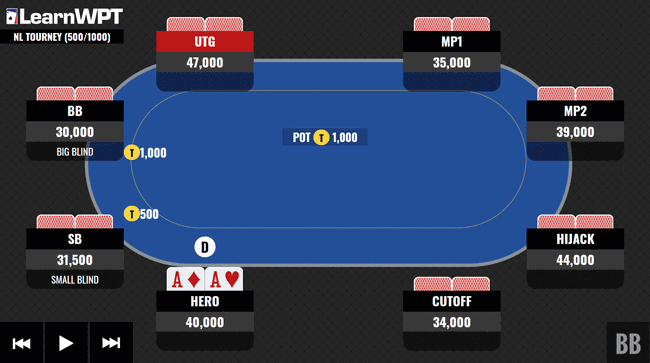A♦A♥ vs the Big Blind, what do you do here?
DECISION POINT: You are 8-handed in the middle stages of a Tournament where blinds are 500/1,000 with a 1,000 big blind ante. Action folds to you on the Button with A♦A♥, you raise to 2,500 and the Big Blind calls. Villain checks the 9♥5♠5♣ flop, you bet 4,000, and they call. The turn is 9♠ and the Big Blind checks. Action is on you, what do you do here?
PRO ANSWER: We are in the middle stages of a multi-table tournament with 500/1,000 blinds with a 1,000 big blind ante. Action folds to us and we are dealt red aces on the Button 8-handed. We make a standard raise to 2,500 chips and only the Big Blind calls.
The flop is 9h5s5c. This is an extremely dry flop and the Big Blind should have a very wide range given the odds they were getting to call preflop. That means that it’s possible for the Big Blind to have a five, but their entire range is very wide and our pocket aces are at a massive advantage against their range as a whole.
In spots where we have a huge range advantage in position as the preflop raiser, but not necessarily a nut advantage since our opponent has more 5x than we do, we usually want to bet small, around ⅓ pot. Betting 2,000-2,500 chips here would be optimal, however in the moment we opt to make a ⅔ pot size bet of 4,000 and the Big Blind calls.
Continued below...
The turn is the 9s, which is a card that is much better for our opponent’s range. When Big Blind calls our larger flop bet it’s much more likely their range includes hands like Ax , 88/77/66, 87s/76s/86s, and some 9x and 5x hands. We block the Ax combos because we hold 2 Aces.
Once the board double pairs the Big Blind has far fewer hands in their range that we beat and we can also expect them to call bets across three streets. This is a classic “way ahead, way behind” scenario where either our opponent is likely drawing to 2-4 outs, or we are drawing to 2-4 outs needing one of the 2 aces and the remaining two 9s if they have 5x hands as well.
In these scenarios the best course of action is often to take a passive line to showdown. This line is preferred to keep your opponent’s range as wide as possible so they can potentially bluff some of their worse hands on future streets, and because we lose less in the instances where they have 9x or 5x.
Checking is the best play.
How would you play it?
Share your answer in the comments below!
Improve Your Game Today!
Join LearnWPT and Get:
Think Like a Pro
- The WPT GTO Trainer to play real solved hands and get instant feedback on YOUR leaks
- On-demand access to our full library of 450+ in-depth Strategy Episodes
- All of your poker questions answered with the Ask a Pro Feature
- Expert analysis from LearnWPT Pros using The Hand Input Tool
- Community Forums to discuss all things poker with fellow LearnWPT Members
- Downloadable Tools you can use at and away from the tables
To join (just $5 your 1st month) click the JOIN NOW button at the top of your screen or the button below and start improving your game!
Have Questions about LearnWPT? Email us at [email protected] and we’ll be happy to help!


